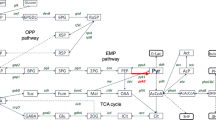Summary
The activity of the phosphoenolpyruvate (PEP) carboxylase isolated from non-saline grown plants of the salt-tolerant plant Mesembryanthemum crystallinum is strongly inhibited by malate. This inhibition was found to depend on the pH (rising with increasing H+-concentrations) and on the concentration of malate used. The addition of inorganic phosphate (appropriate concentration 30 mM) to the in-vitro enzyme assay prior to malate addition results in a remarkable compensation of malate-caused inhibition of the enzyme activity. Again a dependency upon the pH can be observed. The ability of inorganic phosphate to restore malate-caused inhibition of the PEP-carboxylase increases with increasing pH.
Another potent inhibitor of the PEP-carboxylase is NaCl, which shows a minimum inhibition at pH 7. At this pH a concentration of more than 60 mM NaCl is needed to reduce the activity of the enzyme below the control level with a 50% inhibition is reached at 150 mM. If the addition of NaCl is performed in the presence of 30 mM inorganic phosphate the inhibition is less pronounced. The enzyme now tolerates about 100 mM higher concentrations of NaCl without being inhibited.
NaCl-treatment of Mesembryanthemum crystallinum plants results in an increase of inorganic phosphate in the cells with a concomitant establishment of a Crassulacean acid metabolism. The present results support evidence for a protective function of inorganic phosphate (compensation of NaCl-induced enzyme inhibition), possibly a commen reaction involved in the question of salt tolerance, and a more specific function (restriction of malatecaused inhibition of the PEP-carboxylase) providing the enzymatic background for the malate accumulation in Mesembryanthemum crystallinum.
Similar content being viewed by others
Abbreviations
- CAM:
-
Crassulacean Acid Metabolism
- PEP:
-
Phosphoenolpyruvat
Literatur
Bieleski, R. L.: Phosphate pools, phosphate transport, and phosphate availability. Ann. Rev. Plant Physiol. 24, 225–252 (1973)
Flowers, T. J.: Salt tolerance in Suaeda maritima (L.) DUM. The effect of sodium chloride on growth, respiration and soluble enzymes in a comparative study with Pisum sativum L. J. exp. Bot. 23, 310–321 (1972)
Flowers, T. J.: The effect of sodium chloride on enzyme activities from four halophyte species of Chenopodiaceae. Phytochem. 11, 1881–1886 (1972)
Greenway, H., Osmond, C. B.: Salt responses of enzymes from species differing in salt tolerance. Plant Physiol. 49, 256–259 (1972)
Läuchli, A.: Untersuchungen über Verteilung und Transport von Ionen in Pflanzengeweben mit der Röntgen-Mikrosonde. I. Versuche an vegetativen Organen von Zea mays. Planta (Berl.) 75, 185–206 (1967)
Maruyama, H., Easterday, R. L., Chang, H. C., Lane, M. D.: The enzymatic carboxylation of phosphoenolpyruvat. I Purification and properties of phosphoenolpyruvat carboxylase. J. biol. Chem. 241, 2405–2412 (1966)
Osmond, C. B., Greenway, H.: Salt responses of carboxylation enzymes from species differing in salt tolerance. Plant Physiol. 49, 260–263 (1972)
Ting, I. P., Osmond, C. B.: Photosynthetic phosphoenolpyruvat carboxylases. Characteristics of alloenzymes from leaves of C3 and C4 plants. Plant Physiol. 51, 439–447 (1973)
Treichel, S. P., Kirst, G. O., Willert, D. J. von: Veränderung der Aktivität der Phosphoenolpyruvat-Carboxylase durch NaCl bei Halophyten verschiedener Biotope. Z. Pflanzenphysiol. 71, 437–449 (1974)
Ullrich, W., Urbach, W., Santarius, K. A., Heber, U.: Die Verteilung des Orthophosphates auf Plastiden, Cytoplasma und Vakuole in der Blattzelle und ihre Veränderung im Licht-Dunkel-Wechsel. Z. Naturforsch. 20b, 905–910 (1965)
Waygoog, D. J., Mache, R., Tan, C. K.: Carbon dioxide, the substrate for phosphoenolpyruvate carboxylase from maize. Canad. J. Bot. 47, 1455–1458 (1969)
Willert, D. J. von, Kramer, D.: Feinstruktur und Crassulaceen-Säurestoffwechsel in Blättern von Mesembryanthemum crystallinum während natürlicher und NaCl-induzierter Alterung. Planta (Berl.) 107, 227–237 (1972)
Willert, D. J. von: Der Einfluß von NaCl auf die Atmung und Aktivität der Malatdehydrogenase bei einigen Halophyten und Glykophyten. Oecologia (Berl.) 14, 127–137 (1974)
Willert, D. J. von: Stomatal control, osmotic potential and the role of inorganic phosphate in the regulation of the Crassulacean acid metabolism in Mesembryanthemum crystallinum. Plant Sci. Letters (in press)
Wong, K. F., Davies, D. D.: Regulation of phosphoenolpyruvate carboxylase of Zea mays by metabolites. Biochem. J. 131, 451–458 (1973)
Author information
Authors and Affiliations
Rights and permissions
About this article
Cite this article
von Willert, D.J. Die Bedeutung des anorganischen Phosphats für die Regulation der Phosphoenolpyruvat Carboxylase von Mesembryanthemum crystallinum L.. Planta 122, 273–280 (1975). https://doi.org/10.1007/BF00385276
Received:
Accepted:
Issue Date:
DOI: https://doi.org/10.1007/BF00385276




